During the great Revolution Bridaban Taoari made the people of Midnapore excited against the British Imperialism. For which he was hanged till death
Bela Mitra was born in Kodalia, 24-parganas. Her father was Suresh Chandra Bose She was a niece of Subhas Chandra Bose. She was married with Haridas Mtra of Jessore in 1936. She was elected a female commander in the conference anti-compromise movement convened by Subhas Chandra Bose in 1940.When she was only 40years old, she managed to make secret telecommunication with Subhas Chandra Bose in Singapore.This was the first telecommunication connection at that time.in 7th jan 1945.She went to Gandhiji on 21 June 1945 to appeal for the release of her husband, a convict of hang till death. By the grace of Gandhiji his sentence for capital punishment was changed to lifelong imprisonment.She founded Jhansir Rani seba Dal in 1947 of which she became chief commander.Her health deteriorated for excessive presure in the relief work of refugees from East Bengal in 1950. which caused her death.After her death a railway station in between Dankuni and Bali was renamed after her name and gave its name as Belanagar.This was the first example of a railway station in tthe name of an woman.
Saturday, May 31, 2014
Thursday, May 29, 2014
474. Bireshwar Basu (1291-1352), 475. Buddha Saha
Breshwar Basu was born in Midnapore. While he was a professor of Sanskrit in Krishnanagar College he gave up the service at the call of Gandhiji and joined Freedom movement.He courted arrests many times for joining civil disobedience movement.. Once he performed self Satyagraha.
Buddhu Saha was a hero of the Fakir Bidroha. (The Sannyasi Rebellion or Sannyasi Revolt (Bengali: সন্ন্যাসী বিদ্রোহ, The Monks' Rebellion) were the activities of sannyasis and fakirs (Hindu and Muslim ascetics, respectively) inBengal, India in the late 18th century. It is also known as the Fakir-Sannyasi Rebellion (ফকির-সন্ন্যাসী বিদ্রোহ) which took place around Murshidabad and Baikunthupur forests ofJalpaiguri. Historians have not only debated what events constitute the rebellion, but have also varied on the significance of the rebellion in Indian history. While some refer to it as an early war for India's independence from foreign rule, since the right to collect tax had been given to the British East India Company after the Battle of Plassey in 1757, others categorize it as acts of violent banditry following the depopulation of the province, post the Bengal famine of 1770). He kept rising of the flag of fakir Biroha in the forest area of bagura.
Buddhu Saha was a hero of the Fakir Bidroha. (The Sannyasi Rebellion or Sannyasi Revolt (Bengali: সন্ন্যাসী বিদ্রোহ, The Monks' Rebellion) were the activities of sannyasis and fakirs (Hindu and Muslim ascetics, respectively) inBengal, India in the late 18th century. It is also known as the Fakir-Sannyasi Rebellion (ফকির-সন্ন্যাসী বিদ্রোহ) which took place around Murshidabad and Baikunthupur forests ofJalpaiguri. Historians have not only debated what events constitute the rebellion, but have also varied on the significance of the rebellion in Indian history. While some refer to it as an early war for India's independence from foreign rule, since the right to collect tax had been given to the British East India Company after the Battle of Plassey in 1757, others categorize it as acts of violent banditry following the depopulation of the province, post the Bengal famine of 1770). He kept rising of the flag of fakir Biroha in the forest area of bagura.
473. Birendranath Shasmal (1881-1934)
Birendranath Sasmal
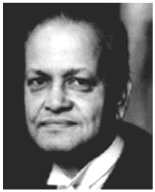

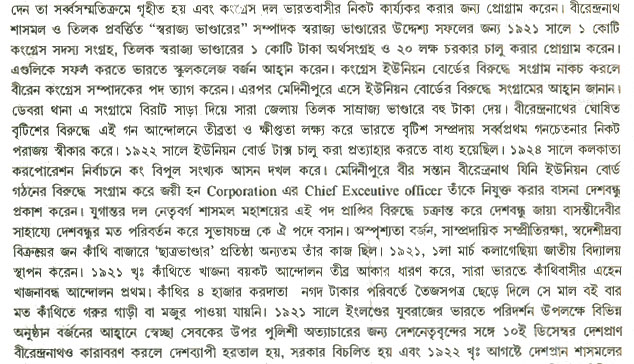
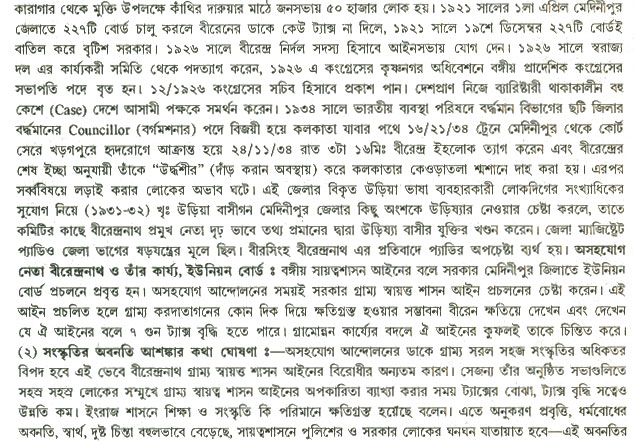
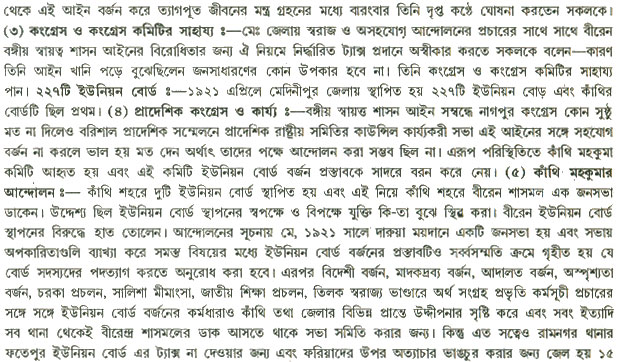
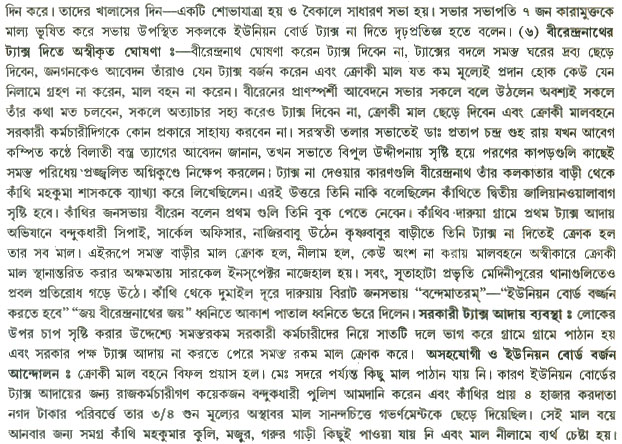
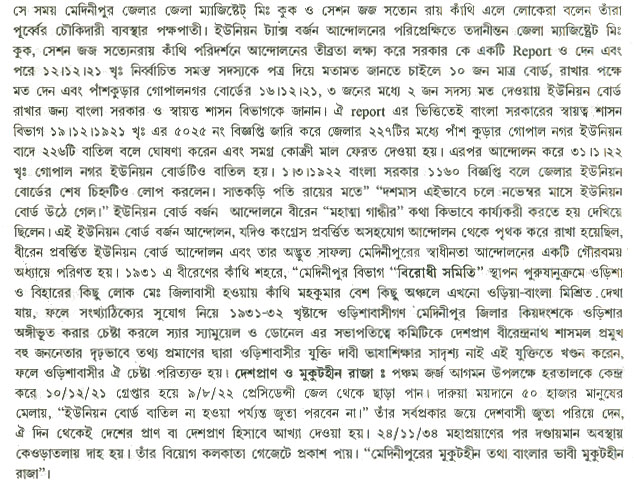

‘The Uncrowned King'! ‘The Black Bull'! ‘Deshpran'! –The titles given to him by the people, out of love, appreciation and admiration, speak volumes of the man who said, “For whom shall Ilive,if not for the people ?” and who, when the European S.D.O. of Contai threatened to make the town a second Jalianwalabag,said to his face that then he would be the first person to lay bare his bosom for the British bullet.
Parentage & early life:
On the 24th November, Birendranath was born at Chandiveti, a village a few miles from the Kanthi (Contai) town. His father's name was Biswambhar Sasmal and mother's Anandamoyee. He passed the Entrance Examination in 1900 and got admission into Ripon College of Calcutta for higher education. He went to England to study law, came back as a barrister and joined Calcutta High Court in 1904. Active Life – (1905 to 1911) : Openly for administrative reason,but covertly for a political one,Midnapore District was proposed to be divided into two.The southern part of the district including Contai was to be named Hijli District and Kharagpur was to be the administrative Center.Birendranath toured from one end of the region to another and organized the protest movement.The attempt of partition was foiled and the proposal was withdrawn. 1913 – Leaving Calcutta High Court, Birendranath practiced in Midnapore District Court for a few years but,in 1913,he again joined the High Court.In the High Court, he defended the accused in the Chittagong Armed Robbery case (the first organized armed struggle for independence after 1857)without taking any fee. (1920) –Non-Co-operation Movement.
In Nagpur Congress in 1920,non-co-operation programme was passed. Chittaranjan Das was the President of Bengal Congress and Birendranath was its Secretary.In response to Gandhiji's call for non-co-operation, Birendranath was the first to give up his roaring practice and Desbandhu Chittaranjan was the illustrious second.
No – Tax – Movement (1920 –1922 ) Bengal Village Self –Government Act was passed in 1919.According to that law, 227 Union Boards were formed in the district. People were kept in the dark about the whys and wherefores of their introduction.Very few people took part in the election.Generally people regarded the new law as a plea to fleece them.Naturally resentment brewed all through the district.The Congress first consented to a movement against this law but then withdrew the consent. The Uncrowned King of Midnapore took up the cause of his people,and plunged into Boycott Movement. The whole district rose up, but the movement was fiercest in Contai.Birendranath declared that he would walk on bare feet until the Union Boards were not done awey with.The boycott movement gained momentum day by day.People refused to pay tax.Police seized articles of movable property, but nobody was found to carry or buy them.Even the Chowkidars (the village guards)refused to serve the government.At last on 17th December,1921, 226 Union Boards were abolished and the last one was abolished the next year.In a mammoth gathering,with loud cheers,people put shoes on the feet of their favourite leader. Chairman of Midnapore District Board : After Gaya Congress,in 1922,when Chittaranjan Das's demand for Independence in place of Dominion Status was Rejected,the Swarajya Party was formed by Motilal Nehru and while Chittaranjan was the president of its Bengal Unit,Birendranath became its Secretary.In 1923,when election was held for the Midnapore District Board ,the Swarajya party members under the leadership of Birendranath Sasmal had a thumping victory and naturally Birendranath became its Chairman.With limited scope and scanty means,Mr. Sasmal performed a herculean task for an all-round development of the district. Labon Satyagraha (1930) Birendranath's influence played a big role in the movement.His followers took active part in organizing people.Satyagrahis came to Narghat and Pichhhaboni to break Salt Law by peaceful means.The Satyagraha assumed the form of a mass movement in the area. Electtion to Calcutta Corporation & Central Legislative Assembly & Death (1933-1934)
In 1933,Birendranath was elected to Calcutta Corporation in spite of the opposition of the Congress.At the request of Pandit Madan Mohon Malavya,he contested in Central Legislative Assembly election from a two –district seat of Burdwan division and won it but he had breathed his last before the result was announced.
Birendranath Sasmal was an ardent follower of Gandhiji.He had unflinching faith in Non-Violent movement.He thought-violence begets violence.He had some bitter experience in politics.But people loved him.Many Schools,Clubs, Organisations and streets that bear his name clearly indicate his permanent seat in the heart of people. |






472.Birendranath Dattagupta (1891-1910)
BIRENDRA NATH DATTA GUPTA
Safety of persons connected with the prosecution of revolutionary political cases was at discount. It seemed that the dare-devils had the entire situation under their control and could do as they liked. The Alipore Bomb Conspiracy Case roused the imagination of fiery youngmen absolutely unconcerned about their own perils and a series of cases from firing resulting in the death of a trusted Government servant or to one helping the Government in such matters occurred in quick succession. The Government with the police spies and informers, loyalists, guards and watchmen equipped with arms proved to be completely inadequate.
Courageous, intelligent, resourceful young men seemed to be available in plenty as if the political soil of the country had been fertilized by the water of revolution and that the crop of martyrs had been lusty and unending.
The mighty Government of India had a large number of devoted servants who proved themselves through merit as the strong arm of the administration. For their protection and safety the Government maintained a big retinue of guards and watchmen at a huge cost. But the vendetta of the young members of the revolutionary party tracked their path with certainty of an inexorable fate and they realized their objects irrespective of all consequences to themselves. It was like death bringing two persons of the opposite camps in mortal embrace with one another.
BIRENDRA NATH DATTA GUPTA, a mere lad of nineteen asked his leader for some serious action and was granted the distinction of taking charge of Shams-ul-Alam, a redoubtable Deputy Superintendent of Police, and removing him from the field of mischievous activity. Alam had been connected with the Alipore Bomb Conspiracy Trial from the beginning and was accepted by the Government as the most competent officer in such a complicated political affair. He raveled in political cases in favour of the prosecution and it became, as it were, the breath of his nostril.
It transpired, and he became conscious of it, that he was being followed by agents of the revolutionary party and there had been at least two previous attempts on his life after the arrest of the Alipore Conspiracy Case accused. A few days after the death of Ashu Biswas on February 10, 1909, he was shadowed by a young man who was arrested by his guards. Unfortunately for Alam, the man was discharged for want of evidence.
About a week before January 24, 1910, he was followed by a Bengali youth while Alam had been going along the maidan. Due to pluck and swiftness in speed the man was able to evade arrest though closely followed by Alam's men.
As was usual with Alam he was busy helping the lawyers of the Crown in a political case in the High Court on January 24, 1910. At about 5-30 p.m., at the end of the hearing for the day, when Alam after arranging the papers and exhibits came out of the Court room and wended his way towards the staircase which went down to the east entrance of these courts. In front of him was the Advocate General and immediately following him was an armed constable of the Bengal Police deputed to be in attendance on him. He was on the point of reaching, the top of the staircase when he came in contact with a young Bengali who had been, as it seemed, hanging about the verandah and watching the movements of his victim. He was seen by Alam's orderly to hold a revolver in his hand. The boy stretched his arm, aimed at Alam and fired. When hit, Alam shouted pakro (catch him), and handed over the stick he had in his hand to his orderly and almost at the same moment fell to the ground on his back. The shot had penetrated right into the heart. Alam, the devoted Police Officer, died an instantaneous death.
Biren at once got into the stair case when a cry of murder was raised. He came down the stairs unopposed and ran towards the gate on the east of the building facing Old Post Office Street
He was now chased by a mounted police but this was not as troublesome to him as the concourse of men collected on the street. His speed was, as a consequence, greatly restricted. With great difficulty he reached Hastings Street
On January 27, 1910, he was placed before the Chief Presidency Magistrate and the next day he was committed to the High Court Sessions.
At the High Court the case started on January 31, 1910. The accused looked pale, calm and completely unconcerned and entered the dock with a sweet smile on his lips. He was charged with murder of Shams-ul-Alam on January 24, 1910. The accused made no reply except that he did not want the help of any Counsel as he was going to plead guilty. Nobody was present in court room for watching the case on his behalf. The accused did not like to say anything. He refused to put any question to anybody, or to produce defense witness or address the Jury.
The Jury without retiring unanimously gave the verdict of 'guilty'. The Judge delivered a sentence of death.
The sentence was received calmly. Biren stepped down the dock into the cell rather cheerfully and wore a beautifully shining smiling face.
While awaiting trial at the High Court the accused expressed desire to eat kachuri, sandesh and rasogolla which were supplied to him.
It was reported that Biren had before his execution made a statement incriminating Jatin Mukherjee and a few others as having asked him to commit the outrage. It came to be known that the police got a page of a newspaper printed afresh containing insinuations against Biren by his leader Jatin Mukherjee with the sole object of extracting a confessional statement of the condemned boy. It was one of the vilest acts in a criminal trial when a young boy of eighteen, face to face with death, was duped to make the case of several other persons implicated in offences of a serious nature rather worse. Before Biren's execution he came to know of this diabolical underhand game on the part of the police and regretted his action and craved forgiveness of Jatin Mukherjee who had absolute faith in Biren as incapable of doing any mean act in normal circumstances.
Biren was executed on February 21, 1910.
The brave lad displayed no special aptitude for any serious political activity, just like the many others of his associates. A Vaidya by birth, he hailed from Bikrampore,Dacca
Biren came to Calcutta Bechu Chatterji Street
On the day of occurrence he turned up at 8-30 or 9 a.m. and stayed in the mess up till 11 a.m. showing no signs of the inner storm that had been lashing the mind.
Wednesday, May 28, 2014
471.Virndranath Chattopadhyay (1880-1937)
Virendranath Chattopadhyaya (Bengali: বীরেন্দ্রনাথ চট্টোপাধ্যায়), alias Chatto, (1880 – 2 September 1937, Moscow), was a prominent Indianrevolutionary who worked to overthrow the British Raj in India by using the force of arms as a tool. He created alliances with the Germans during World War I, was part of the Berlin Committee organising Indian students in Europe against the British, and explored actions by the Japanese at the time.
He went to Moscow in 1920 to develop support by the Communists for the Indian movement, including among Asians in Moscow who were working on revolutionary movements. He joined the German Communist Party (KPD). He lived in Moscow for several years in the 1930s. Arrested in July 1937 in Joseph Stalin's Great Purge, Chatto was executed on 2 September 1937
Virendranath Chattopadhyay 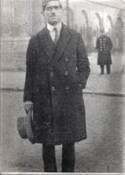
Virendranath Chattopadhya
Born 1880
Hyderabad, India. Died 1937 (Presumed)
Believed to be Soviet Union Other names Chatto Organization Jugantar, India House, Berlin Committee, League against Imperialism
Political movement
Indian Independence movement,Indo-German Conspiracy, Anti-imperialism

Virendranath Chattopadhya
Hyderabad, India.
Believed to be Soviet Union
Political movement
Early life
His childhood nickname was Binnie or Biren. Born in a Hindu Kulin Brahmin family, Virendranath was the eldest son (the second of eight children) of Dr. Aghorenath Chattopadhyaya (Chatterjee), a scientist-philosopher and educationist who was an ex-principal and professor of science at the Nizam College, and his wife Barada Sundari Devi, a poetess and singer in a Bengali family settled in Hyderabad. Their children Sarojini Naidu and Harindranath Chattopadhyay became well-known poets and parliamentarians. Their daughter Mrinalini (Gannu) became a Nationalist activist and introduced Viren to many of her circle in Kolkata (Calcutta). A younger son Marin became involved with Viren in political activism.
Viren received a secular and liberal education. He was a polyglot and was fluent in the Indian languages Telugu, Tamil, Bengali, Urdu, Persian, Hindi, as well as English; later he was to learn French, Italian, German, Dutch, Russian and the Scandinavian languages as well. He matriculated in the University of Madras and received an undergraduate degree in Arts from the University of Calcutta. In Kolkata (Calcutta), through his sister Gannu (Mrinalini), already known as an advanced Nationalist, Viren was introduced to Bejoy Chandra Chatterjee, abarrister and extremist. Chatto met Sri Aurobindo’s family, especially his cousins, Kumudini and Sukumar Mitra; the former was editor of the seditious magazine, Suprabhat. For years afterwards, Viren/Chatto maintained contact with all of them.
In England
In 1902, Viren joined the University of Oxford, while preparing for the Indian Civil Service. Later, he became a law student of the Middle Temple. While frequenting Shyamji Krishnavarma’s India House at 65 Cromwell Avenue in London, Viren became closely acquainted with V.D. Savarkar (since 1906). In 1907, Viren was on the editorial board of Shyamji’sIndian Sociologist. In August, along with Madame Cama and S.R. Rana, he attended the Stuttgart Conference of the Second International where they met delegates includingHyndman, Karl Liebknecht, Jean Jaurès, Rosa Luxemburg and Ramsay Macdonald, among others. Vladimir Lenin attended, but it is not certain if Viren met him on this occasion.
In 1908, at "India House" he came in contact with a number of important "agitators" from India: G.S. Khaparde, Lajpat Rai, Har Dayal, Rambhuj Dutt and Bipin Chandra Pal. In June 1909, at an India House meeting, V.D. Savarkar strongly advocated assassinations of the Englishmen in India. On 1 July, at the Imperial Institute in London, Sir William Curzon-Wyllie, political aide-de-camp at the India Office, was assassinated by Madanlal Dhingra, who was deeply influenced by Savarkar. Viren published a letter in The Times on 6 July in support of Savarkar, and was promptly expelled from the Middle Temple by the Benchers . In November 1909, he edited the short-lived but virulent nationalist periodical Talvar (‘The Sword').
In May 1910, seizing the opportunity of tension between England and Japan over the Korean peninsula, Viren discussed the possibility of Japanese help to Indian revolutionary efforts. On 9 June 1910, along with D.S. Madhavrao, he followed V.V.S. Aiyar to Paris, to avoid a warrant issued for his arrest. Upon reaching France, he joined the French Section of the Workers' International (SFIO).
In Paris
Aiyar returned to India and settled in Pondicherry, where he published the Dharma newspaper and a number of political pamphlets in Tamil, while maintaining a regular contact with Madame Bhikaiji Cama in Paris. Chatto and some other revolutionaries stayed with her at 25 rue de Ponthieu and helped her to edit the Bande Mataram: its April 1911 issue "was one of the most violent that ever appeared,” praising outrages in Nasik and Kolkata. It said:
"With gentlemen we can be gentlemen, but not with rogues and scoundrels. (…) Our friends the Bengalis have also begun to understand. Blessed be their efforts. Long be their arms."
In connection with the Tirunelveli Conspiracy Case in February 1912, Madame Bhikaiji Cama published an article showing that these political assassinations were in accord with the teachings of the Bhagavad Gita.
Marriage and family
In 1912 Viren married Miss Reynolds, an Englishwoman. Demoralised by the outbreak of the Great War, they separated. His wife returned to England as Viren went to Berlin in April 1914 to further revolutionary activities. He also sent fellow revolutionary Herambalal Gupta to Japan via the USA.
In Germany
In Germany to avoid suspicion, he enrolled in a university as a student. As a student in comparative linguistics at the University of Saxe-Anhalt in April 1914, Viren met Dr. Abinash Bhattacharya alias Bhatta and some other nationalist Indian students. The former was well-known to the influential members as belonging to the Kaiser’s immediate circle. Early in September 1914, they formed a "German Friends of India" Association, and were received by the brother of Wilhelm II. The Indians and Germans signed a treaty in favour of German help to oust the British from India. With the help of Baron Max von Oppenheim, who was an expert in Middle Eastern affairs in the German Foreign Office, Viren informed Indian students in thirty-one German universities about the Association’s future plans.
Among its first members were Viren alias Chatto, Bhatta, Dr. Moreshwar Govindrao Prabhakar (Cologne), Dr Abdul Hafiz (Leipzig), C. Padmanabhan Pillai (Zurich), Dr. Jnanendra Dasgupta (Zurich), Dhiren Sarkar, Narain S. Marathé, Vishnu Suktankar, Gopal Paranjapé, Karandikar, Shrish Chandra Sen, Satish Chandra Ray, Sambhashiva Rao, Dadachanji Kersasp, Mansur Ahmad, Siddiq. Other prominent revolutionaries who soon found their way to Berlin were Har Dayal, Taraknath Das, Mohammad Barakatullah, Bhupendranath Datta, A. Raman Pilla (A.R.Pillai), Chandrakanta Chakravarti, M.P. Tirumal Acharya, Herambalal Gupta, Jodh Singh Mahajan, Jiten Lahiri, Satyen Sen, and Vishnu Ganesh Pingley
On 22 September 1914, Sarkar and Marathé left for Washington, D.C. with a message for the German ambassador, Von Bernstorf. He ordered Von Papen, his Military Attaché, to arrange for steamers, and purchase arms and ammunition, to be delivered on the eastern coast of India. On 20 November 1914, Viren sent Satyen Sen, V.G. Pingley and Kartâr Singh to Kolkata with a report for Jatindranath Mukherjee or Bagha Jatin. Bagha Jatin sent a note through Pingley and Kartar Singh to Rash Behari Bose, asking him to expedite preparations for the proposed armed uprising. In 1915, Viren went to meet Raja Mahendra Pratap in Switzerland and tell him of the Kaiser’s personal invitation to meet. He was dogged by the British agent, Donald Gullick, and an attempt was made to kill Viren.
Revolutionary vagabond
With the failure of the Indo-German Zimmermann Plan, in 1917 Viren shifted the Berlin Committee to Stockholm. In 1918, he contacted the Russian leaders Troinovski and Angelica Balabanova, the First General Secretary of the Communist International. In December, he dissolved the Berlin Committee. In May 1919, he arranged for a secret meeting of Indian revolutionaries in Berlin. In November 1920, in his search of financial and political support exclusively for the revolutionary nationalist movement in India, Viren was encouraged by M.N. Roy (with Borodin’s approval).
He went to Moscow with Agnes Smedley and they became companions, sharing their lives until 1928. Under her influence, Viren coveted the influential position M.N. Roy enjoyed in Moscow. The next year, he was received by Lenin, along with Bhupendra Nath Datta and Panduranga Khankoje. From May to September, he attended the Indian Committee of the Third Congress of Communist International in Moscow. In December 1921 in Berlin, Viren founded an Indian News and Information Bureau with his correspondent Rash Behari Bose in Japan.
According to Sibnarayan Ray, Roy and Viren were rivals for Agnes: "Roy would have liked to work with him since he admired the latter’s intelligence and energy. (…) By early 1926 Chatto had got into good terms with Roy."
At Roy’s instance, Willi Muenzenberg "took Chatto under his wings" in organising an international conference in Europe to inaugurate the League against Imperialism. On the eve of Roy’s mission to China, in January 1927, Chatto wrote to Roy asking "if there is anything further you wish me to do…” On 26 August 1927, he wrote to Roy, after the latter’s return to Moscow from China, asking to help him "directly" to gain admission to the Communist parties of India and Germany. After being advised by Roy, Chatto joined the Communist Party of Germany (KPD).
In 1927, while working as the head of the Indian Languages Section of the KPD, Chatto accompanied Jawaharlal Nehru to the Brussels Conference of the League against Imperialism. Viren served as its general secretary. His younger brother Harin went to Berlin that year to meet him and Agnes. On learning of Jawaharlal Nehru’s becoming president of the Indian National Congress, Viren asked him – in vain – to split the party for a more revolutionary programme of full independence from British imperialism.
From 1930 to 1932, Viren published 28 articles in Inprecor, the Comintern organ, about an ultra-leftist sectarian turn of the Communist Party of India. Between 1931 and 1933, while living in Moscow, Viren continued to advocate anti-Hitler activities, Asian emancipation from Western powers, the independence of India, and Japanese intervention into the Chinese revolution. Among his Korean, Japanese and Chinese friends was Zhou Enlai, the future Prime Minister of the People's Republic of China after its successful Revolution.
Agnes saw him for the last time in 1933 and remembered later:
"…He embodied the tragedy of a whole race. Had he been born in England or America, I thought, his ability would have placed him among the great leaders of his age… He was at last growing old, his body thin and frail, his hair rapidly turning white. The desire to return to India obsessed him, but the British would trust him only if he were dust on a funeral pyre."
Last years
In January–February 1934, Chatto exchanged letters with Krupskaya (Lenin’s widow). On 18 March 1934 he gave a talk about his reminiscences of Vladimir Lenin. He wrote toGeorgi Dimitrov, Comintern’s Secretary-General, on 9 September 1935: "For three years I have been kept away from active work in the Comintern." Clemens Palme Dutt (the brother ofRajani Palme Dutt), mentioned having seen Chatto for the last time in 1936/37 at the department of ethnography of the Academy of Science in Leningrad.
Viren was arrested on 15 July 1937 during the Great Purge of Stalin. His name appeared on a death list among 184 other persons, which was signed on 31 August 1937 by Stalin,Molotov, Voroshilov, Zhdanov and Kaganovich. The death sentence was pronounced by Military Collegium of the Supreme Court of the USSR on 2 September 1937 and Chatto was executed the same day.
On 10 July 1938, Nambiar, Viren’s brother-in-law, wrote to Nehru about the arrest. He replied on 21 July, agreeing to try to find out about Viren’s fate.
Evaluation
James Campbell Ker’s Political Trouble in India: 1907–1917 discusses Viren alias Chatto. He described some of the less appealing aspects of his character and actions.
He was deeply admired by colleagues such as M.N. Roy and Dr. Abinash Bhattacharya for his able leadership, sharp intelligence and sincere emotion.
In his autobiography decades later, Jawaharlal Nehru wrote of Chatto:
"An entirely different type of person was Virendranath Chattopadhyay, member of a famous family in India. Popularly known as Chatto he was a very able and a very delightful person. He was always hard up, his clothes were very much the worse for wear and often he found it difficult to raise the wherewithal for a meal. But his humour and light heartedness never left him. He had been some years senior to me during my educational days in England. He was at Oxford when I was at Harrow. Since those days he had not returned to India and sometimes a fit of homesickness came to him when he longed to be back. All his home-ties had long been severed and it is quite certain that if he came to India he would feel unhappy and out of joint. But in spite of the passage of time the home pull remains. No exile can escape the malady of his tribe, that consumption of the soul, as Mazzini called it… Of the few I met, the only persons who impressed me intellectually were Virendranath Chattopadhyay and M.N. Roy. Chatto was not, I believe, a regular communist, but he was communistically inclined."
Virendranath's family line survives today in Kolkata.
Representation in other media
Chatto was well known in Great Britain and India as a revolutionary. He is believed to have inspired Somerset Maugham's character of "Chandralal" in his short story, "Giulia Lazzari;" (its character of Ashenden was based upon Maugham).. The English writer Agnes Smedley, who was involved with Chatto for eight years, used him as a model for the character Ananda in her novel Daughter of Earth
Friday, May 16, 2014
470. Birsa Munda (1875-1900)
Birsa Munda (1875–1900) was an Indian tribal freedom fighter and a folk hero, who belonged to the Munda tribe, and was behind the Millenarian movement that rose in the tribal belt of modern day Bihar, and Jharkhand during the British Raj, in the late 19th century, thereby making him an important figure in the history of the Indian independence movement.
His portrait hangs in the Central Hall of Indian Parliament, the only tribal leader to have been so honored.
Birsa Munda is named with great respect as one of the freedom fighters in the Indian struggle for independence against British colonialism. His achievements in the freedom struggle became even greater considering he accomplished this before his 25th year.
Birsa Munda was born on 15 November 1875 at Ulihatu, Ranchi District on a Thursday and hence was named after the day of his birth according to the then prevalent Mundacustom. The folk songs reflect popular confusion and refer to both Ulihatu and Chalkad as his birthplace. Ulihatu was the birthplace of Sugana Munda, father of Birsa. The claim of Ulihatu rests on Birsa’s elder brother Komta Munda living in the village and on his house which still exists albeit in a dilapidated condition.
Birsa’s father, mother Karmi Hatu, and younger brother, Pasna Munda, left Ulihatu and proceeded to Kurumbda near Birbanki in search of employment as labourers or crop-sharers (sajhadar) or ryots. At Kurmbda Birsa’s elder brother, Komta, and his sister, Daskir, were born. From there the family moved to Bamba where Birsa’s elder sister Champa was born followed by himself.
After childhood
Birsa’s early years were spent with his parents at Chalkad. His early life could not have been very different from that of an average Munda child. Folklore refers to his rolling and playing in sand and dust with his friends, and his growing up strong and handsome in looks; he grazed sheep in the forest of Bohonda. When he grew up, he shared an interest in playing the flute, in which he became expert. He went round with the tuila, the one-stringed instrument made from the pumpkin, in the hand and the flute strung to his waist. Exciting moments of his childhood were spent on the akhara (the village dancing ground). One of his ideal contemporaries and who went out with him, however, heard him speak of strange things.
Driven by poverty Birsa was taken to Ayubhatu, his maternal uncle’s village. Komta Munda, his eldest brother, who was ten years of age, went to Kundi Bartoli, entered the service of a Munda, married and lived there for eight years, and then joined his father and younger brother at Chalkad. At Ayubhatu Birsa lived for two years. He went to school at Salga, run by one Jaipal Nag. He accompanied his mother’s younger sister, Joni, who was fond of him, when she was married, to Khatanga, her new home. He came in contact with a pracharak who visited a few families in the village which had been converted to Christianity and attacked the old Munda order.
As he was sharp in studies, Jaipal Nag recommended him to join German Mission School but, converting to Christianity was compulsory to join the school and Birsa was thus converted as a Christian and renamed as Birsa David, which later became as Birsa Daud. After studying for few years, he left German Mission School and came under the influence of Vaishna Devotee, Anand Pandey and learnt much about Hindu religious teachings. He read about Ramayan, Mahabharata and other Hindu books.
The Formative Period (1886–1894)
Birsa’s long stay at Chaibasa from 1886 to 1890 constituted a formative period of his life. The influence of Christianity shaped his own religion.
This period was marked by the German and Roman Catholic Christian agitation. Chiabasa was not far for the centre of the Sardars’ activities influenced Sugana Munda in withdrawing his son from the school. The sardars agitation in which Birsa was thus caught up put the stamp of its anti-missionary and anti-Government character on his mind. Soon after leaving Chaibasa in 1890 Birsa and his family gave up their membership of the German mission in line with the Sardar’s movement against it.
He left Corbera in the wake of the mounting Sardar agitation. He participated in the agitation stemming form popular disaffection at the restrictions imposed upon the traditional rights of the Mundas in the protected forest, under the leadership of Gidiun of Piring in the Porhat area. During 1893-4 all waste lands in villages, the ownership of which was vested in the Government, were constituted into protected forests under the Indian Forest Act VII of 1882. In Singhbhum as in Palamau and Manbhum the forest settlement operations were launched and measures were taken to determine the rights of the forest-dwelling communities. Villages in forests were marked off in blocks of convenient size consisting not only of village sites but also cultivable and waste lands sufficient of the needs of villages. In 1894, Birsa had grown up into a strong young man, shrewd and intelligentand undertook the work of repairing the Dombari tank at Gorbera damaged by rains.
While on a sojourn in the neighbourhood of village Sankara in Singhbhum, he found suitable companion, presented her parents with jewels and explained to her his idea of marriage. Later, on his return form jail he did not find her faithful to him and left her. Another woman who served him at Chalkad was the sister of Mathias Munda. On his release form prison, the daughter of Mathura Muda of Koensar who was kept by Kali Munda, and the wife of Jaga Munda of Jiuri insisted on becoming wives of Birsa. He rebuked them and referred the wife of Jaga Munda to her husband. Another rather well-known woman who stayed with Birsa was Sali of Burudih.
Birsa stressed monogamy at a later stage in his life. Birsa rose form the lowest ranks of the peasants, the ryots, who unlike their namesakes elsewhere enjoyed far fewer rights in the Mundari khuntkatti system, while all privileges were monopolized by the members of the founding lineage the ryots were no better than crop-sharers. Birsa’s own experience as a young boy, driven from place to place in search of employment, given him an insight into the agrarian question and forest matters; he was no passive spectator but an active participant in the movement going on in the neighbourhood.
The Making of a Prophet
Birsa’s claim to be a messenger of God and the founder of a new religion sounded preposterous to the mission. There were also within his sect converts from Christianity, mostly Sardars. His simple system of offering was directed against the church which levied a tax. And the concept of one God appealed to his people who found his religion and economical relig healer, a miracle-worker, and a preacher spread, out of all proportion to the facts. The Mundas, Oraons, and Kharias flocked to Chalkad to see the new prophet and to be cured of their ills. Both the Oraon and Munda population up to Barwari and Chechari in Palamau became convinced Birsaities. Contemporary and later folk songs commemorate the tremendous impact of Birsa on his people, their joy and expectations at his advent. The name of Dharti Aba was on everybody’s lips. A folk songs in Sadani showed that the first impact cut across the lines of caste Hindus and Muslims also flocked to the new Sun of religion.
Birsa Munda started to propagate the principles of Hindu religion and advised converted tribal people to peruse their original religious system. Imnpresed by his teachings, he became a prophet figure to the tribal people and they sought his blessings. Birsa Munda advised the people to worship cow and protested cow slaughter.
Birsa Munda and his movement
The British colonial system intensified the transformation of the tribal agrarian system into feudal state. As the tribals with their primitive technology could not generate a surplus, non-tribal peasantry were invited by the chiefs in Chhotanagpur to settle on and cultivate the land. This led to the alienation of the lands held by the tribals. The new class of Thikadars were of a more rapacious kind and eager to make most of their possessions.
In 1856 the number of the Jagirdars stood at about 600, and they held from a village to 150 villages. By 1874, the authority of the old Munda or Oraon chiefs had been almost entirely effaced by that of the farmers, introduced by the superior landlord. In some villages the aborigines had completely lost their proprietary rights, and had been reduced to the position of farm labourers.
To the twin challenges of agrarian breakdown and culture change, Birsa along with the Munda responded through a series of revolts and uprisings under his leadership. The movement sought to assert rights of the Mundas as the real proprietors of the soil, and the expulsion of middlemen and the British. He was treacherously caught on 3 February 1900 and died in mysterious conditions on 9 June 1900 in Ranchi Jail. He didn't show any symptoms of cholera though British government declared that he died because of cholera. Though he lived for a very short span of 25 years, he aroused the mind-set of the tribals and mobilized them in a small town of Chotanagpur and was a terror to the British rulers. After his death the movement faded out. However, the movement was significant in at least two ways . First it forced the colonial government to introduce laws so that the land of the tribals could not be easily taken away by the dikus. Second it showed once again that the tribal people had the capacity to protest against injustice and express their anger against colonial rule. They did this in their own way, inventing their own rituals and symbols of struggle.
His call agaist British Raj was Abua Raj ste Jana, Maharani Raj tandu Jana translated as Let the Kingdom of queen be ended and our Kingdom be established which is remembered in tribal areas of Orissa, Madhya Pradesh, West Bengal and Bihar.
Arrest and death
He was arrested on 3 March 1900 in Jamkopai forest, Chakradharpur while he was sleeping along his tribal guerrilla army which was fighting against British forces. About 460 tribal people were arrested of which one was given with capital punishment, 39 were awarded for transportation for life and 23 for 14 years jail. Birsa Munda died in Ranchi Jail on 9 June 1990 under mysterious circumstances and there was a rumor that he was poisoned.
Birsa Munda in popular culture
His birth anniversary which falls on 15 November, is still celebrated by tribal people in as far as Mysore and Kodagu districts in Karnataka, and official function takes place at his Samadhi Sthal, at Kokar Ranchi, the capital of Jharkhand.
Today, there are a number of organizations, bodies and structures named after him, notably Birsa Munda Airport Ranchi, Birsa Institute of Technology Sindri, Birsa Munda Vanvasi Chattravas, Kanpur, Sidho Kanho Birsha University, Purulia, and Birsa Agricultural University. The war cry of Bihar Regiment is Birsa Munda Ki Jai (Victory to Birsa Munda). In 2008, Hindi film based on the life of Birsa, Gandhi Se Pehle Gandhi was directed by Iqbal Durran based on his own novel by the same name. Another Hindi film, "Ulgulan-Ek Kranti (The Revolution)" was made in 2004 by Ashok Saran, in which 500 Birsaits or followers of Birsa acted
Ramon Magsaysay Award winner, writer-activist Mahasweta Devi’s historical fiction, "Aranyer Adhikar" (Right to the Forest, 1977), a novel for which she won the Sahitya Akademi Award for Bengali in 1979, is based on his life and the Munda Rebellion against the British Raj in the late 19th century; she later wrote an abridged version Birsa Munda, specifically for young readers.
Commemoration
He is commemorated in the names of the following institutions: Birsa Institute of Technology Sindri, Birsa Agricultural University, and the Sidho Kanho Birsha University. The Birsa Munda Athletics Stadium, Birsa Munda Airport,Birsa Institute Of Technical Education (B.I.T.E. Ramgarh), Birsa Munda Central Jail and the Birsa Seva Dal also pay homage to his name..
Subscribe to:
Comments (Atom)




